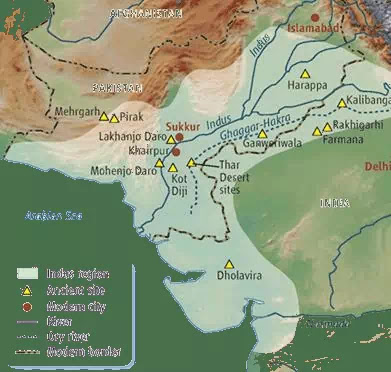INDUS VALLEY CIVILIZATION
The Discoverers of Indus Valley Civilization:
- Alexander Cunningham – He was the first Director-General of ASI. He Began excavations around mid nineteenth century.
- John Marshall – He was the DG of ASI in 1927 and first professional Archaeologist of India.But he excated horizontlly and all finds were grouped together even when they were found at different stratigraphic layers. This caused loss of very valuable information regarding.
- R.E.M. Wheeler – He followed the stratigraphy of excavations rather than just excavating horizontally.
- Harappan ruins were discovered by Marshall, Rai Bahadur Daya Ram Sahni and Madho Sarup Vats.
- Mohenjodaro ruins were excavated for the first time by R.D. Banerjee, E. J. H. MacKay and Marshall.
IMPORTANT FEATURES OF INDUS VALLEY CIVILIZATION
- City was divided into Citadel(west) and Lower Town(east).
- Red pottery painted with designs in black.
- Stone weights, seals, special beads, copper tools, long stone blades etc.
- Copper, bronze, silver, gold present.
- Artificially produced – Faience.
- Specialists for handicrafts.
- Import of raw materials.
- Plough was used.
- Bodies were buried in wooden coffins, but during the later stages ‘H symmetry culture’ evolved where bodies were buried in painted burial urns.
- Sugar cane not cultivated, horse, iron not used.

Indus Valley Civilization Sites Remarkable Features:
- Mohenjodaro
->Great Bath (Largest Brick Work)
->Great Granary (Largest Building)
->Impressive drainage system
->Bronze image of dancing girl
->Image of steatite bearded man
->Piece of woven cotton
->Seal of pashupati
->Prepared Garments
->Skeletons on stairs of well (Mount of the dead)
->located in Sindh province of Pakistan, which is next to the river Indus.
- Lothal
->Artificial Dock (Manchester of Harappan civilization)
->Art of double burial
->Cotton cultivation
->located near the Sabarmati river and Arabian sea, in the Gulf of Khambat, Gujarat,India.
->Rice husk
->House had front entrance (exception).
->Granary & Wooden plough
->Wells in every house
->Fire Altars
->Camels Bone
->located near ghaggar river, rajasthan.
- Harappa
->2 rows of 6 granaries
-> 12 bronze mirrors in a grave.
-> bronze scale
->It is in Punjab Province of Pakistan, located on an old river-bed of River Ravi.
->Lancashire of India
->Only city without citadel
->Bangles Factory
->Beads Factory
->located 80 miles south of Mohenjo Daro in Sindh, Pakistan.
- Rakhigarhi
->Biggest Site
->was discovered in Haryana, India only in 1990.
- Dholavira
->It is situated on ‘Khadir Beyt’, which is an island in Rann of Kutch,Gujarat, India.
-> biggest indus city found in india so far.
-> water reservoir
- Ganeriwala
->It is located in Punjab province of Pakistan and is very near to the Indian border.
- Sutkagen Dor
->It is located in Baluchistan. It is also the westernmost site of Harappan civilization.
- Daimabad
->It is located in Maharashtra near Mumbai.
Reasons for Decline of Indus Valley Civilization
Though there are various theories, the exact reason is still unknown. As per a recent study by IIT Kharagpur and Archaeological Survey of India, a weaker monsoon might have been the cause of decline of Indus Valley Civilization. Environmental changes, coupled with loss of power of rulers (central administration) of Indus valley to sustain the city life might be the cause (Fariservis Theory). There might be resource shortage to sustain the population, and then people moved towards south India. Another theory by Dr Gwen Robbins Schug states that inter-personal violence, infectious diseases and climate change had played a major role in the demise of the Indus Valley Civilization.
Other theories:
- Aryan Invasion : Motimer Wheeler
- Tectonic Movements/ Flood – Robert Raikes
- Change of course of river Indus – Lambrick.





No comments:
Post a Comment